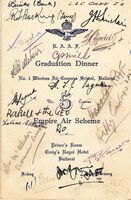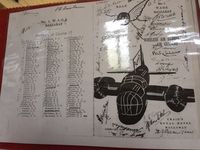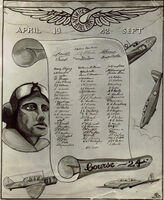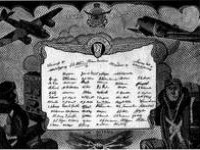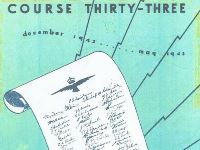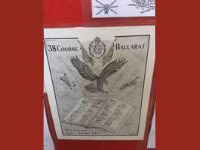1 W.A.G.S. Courses
The Courses at 1 W.A.G.S. Ballarat provided training in Wireless Operation and Navigation with the Gunnery componant of the Courses being held at Bombing Air Gunners School - Evans Head N.S.W. [ 1 BAGS], Port Pirie S.A. [2 BAGS] and Sale, VIC. [ 3 BAGS]
There were 58 Wireless/ Air Gunner Courses and 12 Navigation Courses conducted at 1 W.A.G.S. from 1940 to 1945. The number of trainees on the courses varied, usually between 100 to 150. With the closure of No. 2 and 3 W,A.G.S. the numbers on some courses increased. Not all trainees completed their given course. Some didn't pass the Morse Code componant of the course and others suffered from air sickness. A number of trainees attempted 2 to 3 courses in order to graduate as Wireless Air Gunners. As WW2 progressed there was a need for Air Gunners only to be trained for RAAF service. In all over 6,000 airmen passed through the 1 W.A.G.S.Ballarat school.
The personnel without a Course number are listed in the OTHER section. The RAAF Abbreviations section provides abbreviation information that may have been used in the Personnel Profiles and throughout the website.
The 1 W.A.G.S. POR’s [Personnel Occurrence Reports] together with NAA Digitized Copies were referenced for Course information and names.
The POR’s give the following information-
Name, Service No., Intake date, Course No. [this was not actually stated until later Courses], Outtake Date and Posting To [i.e. AGS , BAGS, etc.]
The WW2 Nominal Roll give the serviceman’s Rank, KILLED or Discharged and Discharge unit, Citations and P.O.W status.
The NAA serviceman’s Digitized Records give 1 W.A.G.S Intake Date, KILLED or Discharged, Course No, Posted to [ i.e. Squadron, Unit ] as well as much more information not included in the COURSE lists. The NAA Digitized Records also enabled our researchers to verify Course No’s and Dates by comparing individual Service Records.
Every effort has been made to complete Course lists of names however there are pages in the POR’s which are unreadable due to their age and condition. It is anticipated new names will be added when more information is discovered.
ABOUT THE COURSES

No 1 Wireless Air Gunners School was formed at Ballarat, Victoria on the 22nd of April 1940 to commence operations on the 29th April 1940. Although not officially named as such Course 1 began on the 30th April 1940 with the following numbers of personnel-
Officers : 4
Airmen {Staff } : 39
Trainees : 77 [Intake]
Total : 120
Each month a new intake of trainees joined a course and after 24 weeks they graduated from Ballarat and moved to 1,2 or 3 BAGS [ Bombing Air Gunners School] to complete the Gunnery component of the course. Courses were later numbered, and trainees took great pride in signing their artfully decorated Course Certificates at their Graduation dinner. These became very prized possessions by trainees and their families. Those who successfully completed the Wireless Operator [Air] Course were authorised to wear the Wireless Operator [Air] Badge. The Air Gunners Badge was awarded after completion of the Gunnery Course at Sale, Victoria.
By 1941 there were nearly 800 personnel on the RAAF Ballarat base and at the end of March 1942 a total of 1238 airmen had been trained. Basic training for wireless operators ceased in May 1945 by which time 6000 trainees had been through the school. 58 Wireless / Air Gunner and 12 Navigator courses were conducted between 1940-1945. It is interesting to note that many early Navigator trainees also completed Wireless Air Gunner Courses. The first Navigator course commenced on the 4/2/1943. Also due to the difficulty of the Wireless course, some trainees failed their first course, and, in order to pass, went on to do two or three courses. Often these courses were six months apart. Some students left 1 W.A.G.S only to return to a new course later or be remustered to W.A.G.S.
Other trainees weren’t required for Wireless and went straight to Air Gunners School depending on the need at the time. 1 W.A.G.S Ballarat also absorbed trainees from 3 W.A.G.S Maryborough Queensland when it was disbanded during 1944. Trainees were also posted from No. 2 W.A.G.S. in Parkes, New South Wales.
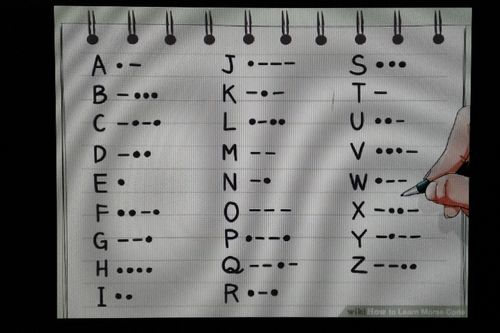
The areas of Wireless training were Morse and electrical science, Morse and radio theory, Morse and practical radio, practical operating of aircraft wireless equipment on the ground and radio sending and receiving from Wackett aircraft trainers. Trainees must then be capable of sending at least 18 words a minute in Morse, either in plain language or code. It was expected that trainees after graduation would be competent enough to take on operational flights immediately. Usually, this level of efficiency would take two and a half years to achieve.
Outstations were set up on the runway for easy access to Anson aircraft. Trainees were taken out by instructors in Air Force tenders to set up their equipment and communicate with the base station in the Outstation. Locations such as Creswick, Lake Wendouree and Burrumbeet were used by the trainees to set up their mobile communication centres.
The following is an excerpt from Tom Runnall's book 'A BABE IN ARMS' A Personel Record of RAAF Service, 1942-1945. Tom graduated from 1 W.A.G.S Course 32.

After slogging away at the Morse Code and wireless theory for an earth bound five months, the eventuality which we were eagerly awaiting finally arrived. We were about to take to the air! Admittedly the training aircraft used, two-man Wacketts, were rather insignificant and unwarlike, but at least they could get us into the air. Whilst in the cramped confines of the rear cockpit, it was imperative not to lose one's essential recording equipment - a small lead pencil! To ensure its safety, the pencil was secured to a piece of string which in turn was tied to the top button of one's overalls, standard dress for trainees while on station. During waking hours, the pencil was kept in the breast pocket with the retaining string prominently displayed, a la old - fashioned watch chain. This signified that we were the top dogs - the graduating course, actually flying. Service life seemed to foster such little foibles, class distinctions seemed important.
An excerpt after Tom's first flight.
From then on it was plain sailing as we wrestled with our equipment flying across to such exotic locations as Bendigo, [OGIDNEB], Colac [CALOC], Clunes [SENULC] etc. Note the coding used to ensure that the enemy were kept unaware of our whereabouts. These flights became almost enjoyable despite struggling with the recalcitrant wireless sets and incipient airsickness when turbulence was encountered.
B.A.G.S and A.G.S
After six months at Ballarat during which at least 20 hours in the air was achieved transmitting and receiving messages most trainees graduated as wireless operators and were sent initially to Evans Head N.S.W., Port Pirie S.A. and then to Sale for Gunnery training, AGS and BAGS [Air gunners School and Bombing Air Gunners School].
Ballarat was not used for this part of the course due to being in a built-up area where gunnery would be a threat to the population. Also, as Sale, Evans Head and Port Pirie are close to the sea practice was often out to sea to imitate real combat situations.
 The purpose of Gunnery school was to learn air-to-air and air-to-ground gunnery on Fairy Battles and Hawker Demons aircraft and mobile gun turrets on the ground.
The purpose of Gunnery school was to learn air-to-air and air-to-ground gunnery on Fairy Battles and Hawker Demons aircraft and mobile gun turrets on the ground.
The air to air was to set on another aircraft which was streaming a drogue and fire ammunition from the G.O [Gas Operated] machine gun in the general direction of the target. As there was no interrupter gear fitted to the Fairy Battles great care had to be exercised so that when shooting at a moving target, the trainees didn’t shoot themselves down. Interrupter gear made the gun inoperative if it was aimed at a plane’s wings, tail or fuselage.
The course requirement was to fire off 2,000 rounds.
Each flight usually lasted about an hour and the student could shoot off 300 rounds per flight.
All of this was with the background scenery at 3 BAGS of the 90-mile beach, the Gippsland Lakes, the mountains and the dense forests.
Air to ground required low sweeps over sandpits about 20 feet square which were divided into targets numbered 1 to 12. As the planes dived the trainees shot off 200 rounds. Each students’ bullets were dyed a different colour which enabled Ground staff to count the number of hits. It was rumoured that two percent accuracy was required to pass this section of the Gunners training.
In order to pass as an Air Gunner there was instruction in turrets, weapons, aircraft recognition and tactics. The trainees learnt how to assemble, disassemble, clean and oil machine guns, load magazines, setting the gun in position in the aircraft, servicing the guns and clearing blockages.
They had to know how the Frazer-Nash turret worked, the motors driving it, the valves and the piping for oil.
For Aircraft recognition, using a projector the instructor would flash an image of perhaps a head-on view of a Ju88 on the screen for a split second and then say “ come on boys, what is it ? Quick Quick – YOUR LIFE DEPENDS ON IT”.
In preparation for firing from an aircraft the trainees fired a camera gun on the ground, taking shots at a model aircraft on a stick carried by an Aircraftsman. They also had practical shooting with a Vickers GO-gun [ gas operated with a round magazine on top which held about 200 bullets] at a rifle range shooting at a target 25 metres away. After shooting the men had to take the gun to pieces, wash the parts in petrol and oil them before putting the gun back together again.
The turret room was a hut with a number of turrets. It was quite difficult to learn to operate the turret at the same time as the machine guns.
At the end of lectures there were several two-hour examinations and oral tests on tactics, aircraft recognition, range procedure, turret handling and how to correct a number of malfunctions of the machine gun while blindfolded.
The Wireless Air Gunners Course took approximately seven months to complete both areas.
After graduation W.A.G.S could be sent to –
- Operational Training Unit East Sale
- Canada
- One of the Wireless or Air Gunnery Schools as an instructor
- To the islands north of Australia to take part in the defence of Australia from a Japanese invasion
- The Middle East
- The United Kingdom
Many trained Wireless Air Gunners became crew members for Bomber Command and were either Wireless operators, sending and receiving Morse-Code messages or a Gunner.
These were two distinct unrelated skills hence the separation of course content and locations.
It should be noted that realistic gunnery training didn’t occur until arrival at an Operational Training Unit [ O.T.U.] in England. The R.A.F equipped its heavy bombers with power-operated turrets armed with .303 Browning machine guns which were not used in training at Sale, Victoria.
The following are extracts from Mike Colman’s book – CREW the Story Of The Men Who Flew RAAF Lancaster J For JIG.
They give an insight into the role of W.A.G.S. as crew members of Lancaster Bombers and the vital contribution they made to RAF Bomber Command during WW2.
The Wireless Operator
The Lancaster Wireless Operator sat in semi-darkness on the port side of the aircraft, directly behind the navigator’s position, with his code book and air log in which he recorded all messages. His T1154/R1155 wireless was known as a Marconi and also as a ‘rainbow’ set because of its multi-coloured knobs.
Most communication with the outside world was by Morse and, except for regular wind speed and direction reports, this was minimal. The Wireless Operator was also kept busy assisting the Navigator by establishing the bomber’s position from base radio transmissions, and it was his task to drop bundles of ‘window’- foil strips intended to confuse German radar.
The Mid-Upper Gunner
The Lancaster had three sets of guns : in the nose, where they were operated by the bomb aimer; in the mid-upper turret; and in the tail turret. The two forward positions were armed with two .303 browning machine guns; the tail gunner operated four. It was up to the two air gunners in each crew to decide which position they would man. The rear gunner was the most vulnerable member of the crew, since attacks by German night fighters almost invariably came from below and behind. The mid-upper gunner was marginally safer, but his position was the most uncomfortable on the aircraft. While the rear gunner was in a cramped and cold space , at least he was seated. The mid-upper gunner spent the flight perched on a triangular strip of canvas slung beneath the domed turret.
The Rear Gunner
Known in the RAF as ‘Tail End Charlie’, the rear gunner was the most exposed , isolated and unprotected of the seven crew members of the Lancaster Bomber. He sat at the back of the aircraft in a cramped, freezing pod, with only a sheet of Perspex between him and the German night fighters.
As the military historian Richard Holmes put it, his was ‘the coldest, loneliest, most dangerous job of all’. And in the Lancaster, the odds of survival were worse than on any other aircraft. Due to factors such as the small size of the escape hatches and, in the case of the rear gunners, the complicated procedure of extricating themselves from the tail turret, only 15% of the crew of any downed Lancaster survived.
New recruits who became crew in Bomber Command were told their life expectancy was ‘ six weeks’. These brave young men aspired to do two tours, which was thirty sorties.
The average was thirteen, so you had to be lucky. You had to beat the average by more than twice to survive. Rear Gunner Jim O’Riordan.
The 1 W.A.G.S course instruction was not without danger with a pilot and trainee being killed on the 22nd March 1943 in a Wackett at Brewster and another two airmen were killed on the 20th February 1944 in a Wackett trainer. There were also many forced landings where the Wacketts were damaged.
Many more casualties happened at the Sale base, the home of the Australian built Beaufort Bombers, as a result of training exercises, flight reconnaissance, type of aircraft and other factors. Over the life of the Bairnsdale and Sale airfields during WW2 nearly 200 lives were lost. Those who were 1 W.A.G.S are commemorated on the MEMORIAL ROLL.
By 1944 with the introduction of “radar” a new course for navigators with a wireless qualification was introduced. This was in conjunction with Avro Anson’s equipped with Air-to-Surface Vessel [ASV] radar. The Wireless Operator category was replaced with that of “Signaller” . On the 20th November 1944, a Radar Training Wing was established and at the graduation parade on the 22nd March 1945, “Signaller” half wings were awarded to 57 graduates. The last Wireless Operators course finished in 1945.
With the introduction into the RAAF of long- range Consolidated B 24 Liberator Bombers three new courses were required. Radar courses for navigators, air bombers and wireless operators. A large intake of officers and NCO’s arrived in January 1945 to begin these courses. By March this training was relocated to the Liberator Operational Training Unit at the RAAF Station at Tocumwal.
Sources - With thanks to
Les Sullivan …….
Not to be Shot at or Exported An Airman’s Letters Home 1942-1945
Mike Colman…….
CREW The Story of the men who flew RAAF Lancaster J for JIG
Alfred Chandler…….
The Saga of 1 WAGS, in Ballarat
William Jack Darcey…….
A Wireless/ Air Gunner’s Story
Dr Allan G. J .Terrett and Dr G. Terrett.......
The Life of Leslie James Terrett 1923-1961 [ James, Jim, Jimmy, Curly]
Tom Runnalls.........
'A BABE IN ARMS' A Personel record of RAAF Service, 1942 - 1945
Lindsay Cheal...........
With thanks - Copies of particular Course Graduation Certificates and Graduation Menus
The Ballarat Aeroclub...................
With thanks - Copies of particular Course Graduation Certificates and photos
The 1 W.A.G.S Personnel Occurrence Reports [POR’s] Volumes 1-9
Links-













